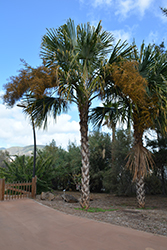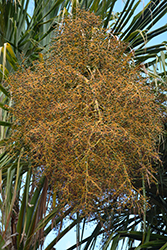It's all about ...
plants

Height: 50 feet
Spread: 20 feet
Sunlight:
![]()
![]()
Hardiness Zone: 9b
Other Names: Savannah Palm, syn. S. allenii, S. glaucescens
Description:
This striking, slender palm makes a perfect vertical landscape accent; drought resistant once established, and prefers slightly alkaline soil; tolerates mild frost only; has a reasonably fast growth rate
Ornamental Features
Bay Palmetto features showy panicles of creamy white flowers held atop the branches in mid spring. It has attractive bluish-green foliage with powder blue undersides and tinges of silver. The large lobed palmate leaves are highly ornamental and remain bluish-green throughout the winter. The fruits are showy black drupes displayed from early fall to mid winter. The rough gray bark adds an interesting dimension to the landscape.
Landscape Attributes
Bay Palmetto is an evergreen tree with a strong central leader and a towering form, with a high canopy of foliage concentrated at the top of the plant. Its average texture blends into the landscape, but can be balanced by one or two finer or coarser trees or shrubs for an effective composition.
This is a relatively low maintenance tree, and is best pruned in late winter once the threat of extreme cold has passed. It has no significant negative characteristics.
Bay Palmetto is recommended for the following landscape applications;
- Accent
- Vertical Accent
- Naturalizing And Woodland Gardens
- Container Planting
Planting & Growing
Bay Palmetto will grow to be about 50 feet tall at maturity, with a spread of 20 feet. It has a high canopy of foliage that sits well above the ground, and should not be planted underneath power lines. As it matures, the lower branches of this tree can be strategically removed to create a high enough canopy to support unobstructed human traffic underneath. It grows at a fast rate, and under ideal conditions can be expected to live for 60 years or more.
This tree does best in full sun to partial shade. It does best in average to evenly moist conditions, but will not tolerate standing water. It is particular about its soil conditions, with a strong preference for sandy, alkaline soils. It is highly tolerant of urban pollution and will even thrive in inner city environments. This species is not originally from North America.
Bay Palmetto is a fine choice for the yard, but it is also a good selection for planting in outdoor pots and containers. Because of its height, it is often used as a 'thriller' in the 'spiller-thriller-filler' container combination; plant it near the center of the pot, surrounded by smaller plants and those that spill over the edges. It is even sizeable enough that it can be grown alone in a suitable container. Note that when grown in a container, it may not perform exactly as indicated on the tag - this is to be expected. Also note that when growing plants in outdoor containers and baskets, they may require more frequent waterings than they would in the yard or garden. Be aware that in our climate, most plants cannot be expected to survive the winter if left in containers outdoors, and this plant is no exception. Contact our experts for more information on how to protect it over the winter months.
This plant is not reliably hardy in our region, and certain restrictions may apply; contact the store for more information.

